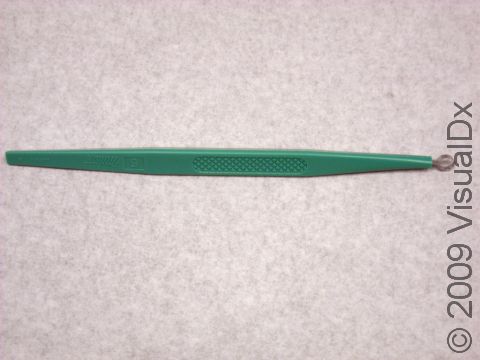Curettage
Curettage, in dermatology, is a surgical procedure that uses a curette, a small scoop-shaped instrument, to scrape off noncancerous skin growths (such as seborrheic keratoses and pyogenic granulomas), precancerous skin growths (such as actinic keratoses), and some skin cancers (such as early basal cell carcinomas and early squamous cell carcinomas, known as squamous cell carcinoma in situ).
Curettage for precancers is often followed by electrodesiccation, where a high-frequency electric needle dries the tissue following curettage and stops any minor bleeding. For skin cancers, the standard treatment is to perform curettage and electrodessication 3 times in succession.
What to Expect During Your Visit
At the time of the procedure, the area to be treated is cleaned with an alcohol wipe or antiseptic. The medical professional will numb the area with a local anesthetic injected into the skin. The medical professional will then use the curette to scrape the skin and remove the growth. An electric needle or a liquid such as aluminum chloride may be applied to stop any minor bleeding where the lesion was removed. The medical professional will apply petroleum jelly (eg, Vaseline) or antibacterial ointment and a bandage to protect the wound as it heals.
The medical professional may send out the skin sample for biopsy, which involves examining the tissue under a microscope to confirm the clinical diagnosis.
What to Expect After Your Visit
Following curettage, there may be minor oozing or bleeding. If so, apply a clean gauze pad to the area and place pressure on it for 5-10 minutes. There may be pain after the local anesthetic wears off, but this is usually easily controlled with pain reliever such as acetaminophen (eg, Tylenol). At first, there will be a sunken wound. The area should then form a scab that will fall off within a few weeks. Typically, there will be a small scar that fades with time.
Follow-Up Care
Follow your medical professional’s advice for at-home care following curettage. Typically, the wound should not be washed for the first 24-48 hours to allow for proper healing. Then, the area can be cleaned with gentle soap and water. You can apply petroleum jelly (eg, Vaseline) and cover the area with a new bandage daily until the wound heals.
Risks and Potential Side Effects
Typically, there will be a scar following curettage, especially when it is followed by electrodesiccation. Sometimes a keloid forms, which is a thick, raised scar.
There is also a risk of skin infection.
When to Seek Medical Care
Contact your medical professional if you experience:
- Bleeding that does not stop.
- Pain that does not go away.
- Signs of infection, such as pain, spreading redness, or fever.
References
American Cancer Society. Curettage and electrodesiccation. American Cancer Society. https://www.cancer.org/cancer/types/skin-cancer/skin-biopsy-treatment-procedures/curettage-electrodesiccation.html. Updated 2021 Apr 16. Accessed 2024 Apr 5.
Mazzoni D, Muir J. A guide to curettage and cautery in the management of skin lesions. Aust J Gen Pract. 2021;50(12):893-897.
Last modified on June 24th, 2024 at 11:58 am

Not sure what to look for?
Try our new Rash and Skin Condition Finder
